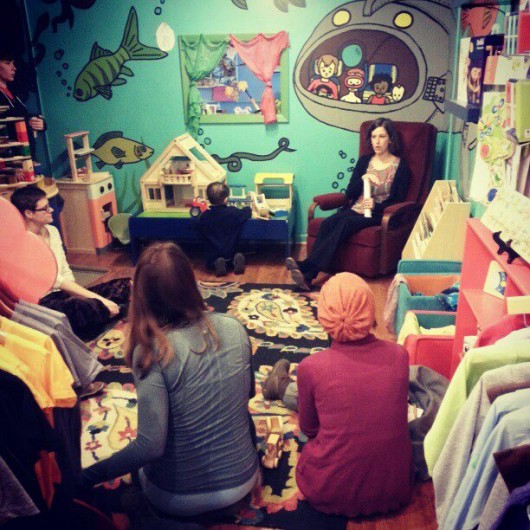Play Smart! (How to increase your child’s intelligence with imaginative play)
- 4 ways your child may not tolerate cow’s dairy: allergy, milk protein sensitivity, cerebral folate deficiency, and lactose intolerance - January 3, 2024
- 5-hydroxytryptophan (5-HTP) and the “feel good” neurotransmitter serotonin - October 4, 2023
- Quercetin supplementation for children: research, safety and efficacy - May 13, 2023
 This last Saturday I had the wonderful pleasure of teaching a short class on imaginative play at Walking Stick Toys here in Missoula. Walking Stick Toys is an awesome toy store dedicated to selling all natural wood, wool, silk and cotton toys – toys that are healthy and stimulate the imagination! I love it!
This last Saturday I had the wonderful pleasure of teaching a short class on imaginative play at Walking Stick Toys here in Missoula. Walking Stick Toys is an awesome toy store dedicated to selling all natural wood, wool, silk and cotton toys – toys that are healthy and stimulate the imagination! I love it!
For those of you who missed the class, or want a refresher, here are my notes:
Intro:
Why play? Play is a fantastic way to learn. Play engages the brain in a way that no other activity can. It uses language, spatial reasoning, planning, cooperation, strategy and social understanding. Play often involves math and physics and sometimes reading and writing as well.
Researchers actually use imaginative play as an evaluation tool to assess a child’s development. Normal children have robust imaginations and are able to use objects creatively, whereas developmentally delayed children often have difficulty with this. Researchers particularly use imaginative play to assess the social development of autistic children.
Point number 1: Reinforce repetition.
Kids are scientists.
Here is a scene that every parent has experienced: your child dropping food off his highchair onto the floor. It was funny the first time, but after eighty five hundred times the cuteness ceases and it just becomes really annoying. Annoying to the parent, that is! Your child is still enthralled with the sequence of events that occurs after dropping the umpteenth cheerio to the floor. Why? Because it is a great experiment! The cheerio dropping experiment involves physics (gravity), object permanence (the cheerio still exists even though it is out of sight), and lots of sociology and psychology (how do Mom and Dad react to me dropping it?).
In science we call this using a large sample size. The large sample size helps us predict overall trends. In the cheerio dropping experiment, for example, your child learns that when she drops the cheerio 95% of the time it lands within a 2 square foot radius, and perhaps 4.5% of the time within another square foot radius. Rarely the cheerio rolls across the floor, and never does the cheerio fall upwards or sideways.
So though the cheerio experiment is incredibly boring to the parent, it is still our job to encourage our child’s repetitive play. It is an important part of their development!
Point number 2: Safety.
Research has shown us that the most important thing for proper brain development is a safe environment. This is most important during the first year of life, when parts of the brain are forming connections that will persist for a lifetime. One center in the brain is called the amygdala, and is responsible for perceiving fear and other emotions. The amygdala in normal, healthy adults is linked to the memory centers of the brain – which is why certain memories are tied to emotional feelings (and vice-versa). In children who come from extremely dysfunctional homes this amygdala gets wired inappropriately, leading to false associations between emotions and memories, making it difficult to learn new information. Children who have large, healthy amygdalas have been shown to have greater language development.
So safety is the first priority for the developing brain in infancy. But I would also argue that it is important for children to be in an atmosphere of safety to facilitate imagination and imaginative play. Children who are discouraged from using their imaginations are less apt to play in this manner, and thus less apt to receive all the good benefits you can get from creative play.
Point number 3: Play needs rules.
In the 1972 there was a famous research study done called the Stanford Marshmallow experiment. Researchers brought kids into a room and showed them one marshmallow (sitting on a desk). They explained to the children that if they could wait fifteen minutes that they could then have two marshmallows to eat instead of one. The researchers then left the room. Some kids ate the marshmallow right away, but most at least attempted to wait. Only about a third of the children were able to wait the fifteen minutes.
Many years later the researchers looked at the data again and saw a new correlation: the children who could wait had higher SAT scores later as adolescents. Researchers concluded that the ability to govern self-control was more important in determining test scores than reading, writing and math abilities alone. Pretty interesting!
A Russian psychologist named Vygotsky established a theory that imaginative play develops the same type of self-regulation that stimulates intelligence. When children play they adopt certain rules that regulate their play. I’ll use the example of my nephew and his grandmother – they used to play “Postman” and customer. My nephew had to wait for his grandma to “call” the post-office requesting her package, then he had to ring the “doorbell” and wait for her to answer before delivering it. In this he learned self-regulation by waiting, but also by restricting himself to the role of Postman (i.e., he can’t be both a Postman and a customer, nor can he be a Postman and a Fireman at the same time).
There’s a whole preschool development program called Tools of the Mind that is dedicated to using research-based methods to increase a child’s learning. They use Vygotsky’s theory to set up a curriculum that stimulates self-regulatory behavior in children. In their classroom they have children write up a “Play Plan” before each day. (E.g., “Today I am going to play Fireman with my friend. Then I will build with Legos.”)
So to encourage your child to self-regulate, make sure to enforce the “rules” of whatever game they are playing. The best part is that the child themselves can set the rules. Also ask your child what they are doing or what they are playing – this will help them be more self-aware in addition to elucidating the rules of the game.
Point number 4: Play helps children understand the world around them.
The famous psychologist Piaget theorized that children use play to make sense of the world around them. I’m sure you have all seen this: a child sees a major event and in the subsequent days (or weeks or months) she re-creates the event using her toys. Piaget used the example of a fire in a neighboring house – the child sees the firefighters, trucks and hoses as well as the flurry of activity during the event. For the next month he uses blocks as “houses” and pretends being a firefighter using his hose to put out the fire.
Piaget called this accommodation and assimilation. The child uses her play to repeat the event enough times to make sense of what happened (in a controlled, safe environment). When your child does this – encourage it! It is also a great time to talk things through with your child, or provide “alternate endings” to traumatic events through play.
Point number 5: Praise effort not intelligence.
This one is so hard to remember, but is so key to boosting your child’s potential. We all do it – when our child does something brilliant, or brings home a good test score, the first thing out of our mouths is “You’re so smart!”
Wrong! We need to say something entirely different: “You must have worked so hard!”
Why? Research has shown that kids who are praised for intelligence develop fewer learning strategies than kids who are praised for effort. Kids who are taught that they are smart learn that their identity is “smartness” – they often become more concerned with “being smart” than they are with learning. When these kids finally do get a bad grade the logical conclusion is that they are no longer smart, and thus can’t increase their test scores.
In contrast, the child who is praised for effort learns that his bad grade is due to either lack of effort, or not understanding the problem. Both of these are solvable dilemmas. Children praised for effort are consistently more creative problem solvers. They also appreciate learning for the sake of learning rather than for a test score.
Interestingly, other societies do not have the same approach to intelligence and learning that we have here in the states. Carol Dweck, a researcher who established the “Praise Effort not Intelligence” theory, also studied societal beliefs about intelligence. She found that in the states many people generally believe that smart people are smart from birth and stay smart. Contrast this belief with what she found in many Asian societies: that anyone can be smart given hard work. Interesting, since in our American culture we often think of “Asians” as “the smart kids!”
So there you go – praise your child for “working hard!”
Whew! That was long, and I barely scratched the surface of my lecture. I hope you enjoyed it!
For more reading, I suggest checking out the Tools of the Mind classroom curriculum. Also read the book Brain Rules for Baby – which is where much of my initial research for this talk came from. He has a whole book full of interesting ways to increase your child’s intelligence.







